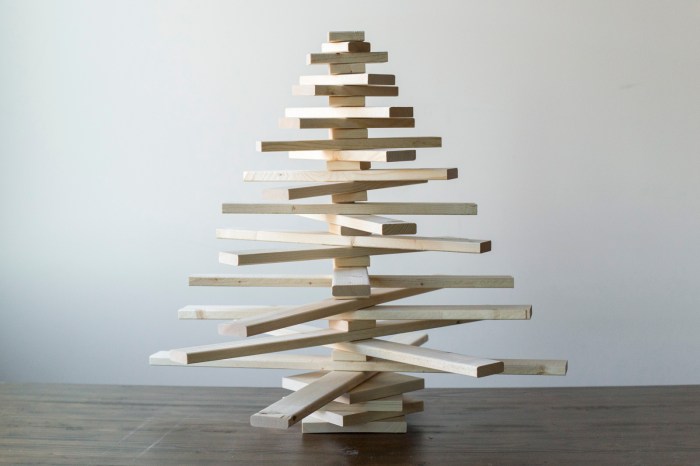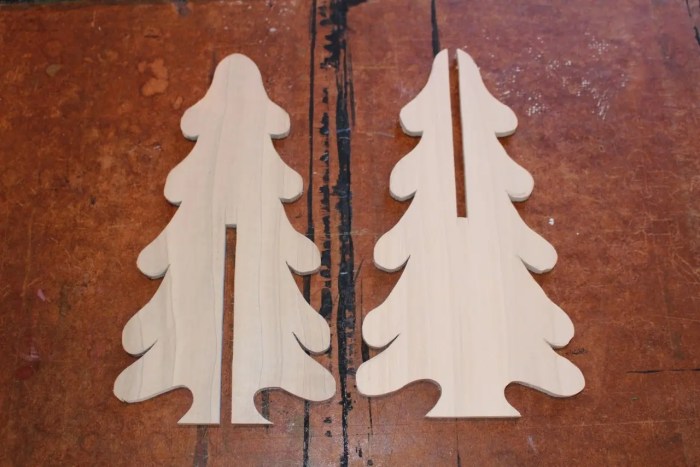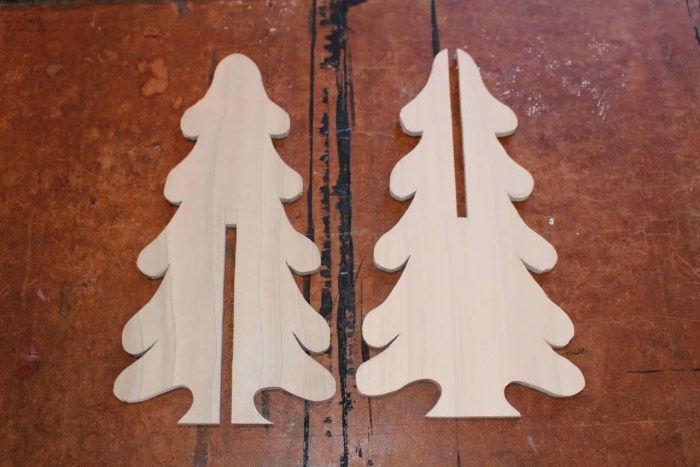DIY wood Christmas tree plans offer a unique and charming alternative to traditional artificial or live trees. Crafting your own wooden Christmas tree allows you to personalize your holiday decor, embrace sustainability, and create a lasting centerpiece for your home.
From classic designs to modern interpretations, the possibilities are endless. Whether you’re a seasoned woodworker or a beginner looking for a rewarding project, building a DIY wood Christmas tree is a delightful way to celebrate the holiday season.
Safety Considerations: Diy Wood Christmas Tree Plans
Building a wooden Christmas tree is a fun and rewarding project, but it’s essential to prioritize safety throughout the process. Working with wood and tools can be hazardous if proper precautions are not taken.
Power Tool Safety
Power tools can be incredibly useful for woodworking projects, but they also pose a significant risk of injury if not used correctly. Here are some crucial safety guidelines to follow:
- Always wear eye protection, such as safety glasses or goggles, when operating power tools. Flying debris can cause serious eye injuries.
- Ensure that the power tool is properly plugged in and that the cord is not damaged or frayed. A damaged cord can cause electrical shocks.
- Use the correct tool for the job. Don’t try to force a tool to do something it wasn’t designed for. This can lead to accidents.
- Keep your fingers away from the blade or cutting surface of the tool. Always use a push stick or guide to keep your hands away from the danger zone.
- Never leave a power tool running unattended. Always turn off the tool and unplug it when you are not using it.
Handling Sharp Objects
Sharp objects, such as knives, chisels, and saws, are essential for woodworking. However, they can cause serious cuts if handled carelessly. Here are some safety tips to prevent injuries:
- Always use a cutting board or other stable surface when working with sharp objects. This will help to prevent the object from slipping and causing an injury.
- Keep your fingers away from the cutting edge of the tool. Always use a push stick or guide to keep your hands away from the danger zone.
- Store sharp objects in a safe place, such as a tool box or drawer, when not in use. This will prevent accidental cuts.
- Use caution when handling sharp objects. Be aware of your surroundings and avoid distractions.
Working with Hazardous Materials
Woodworking projects may involve the use of hazardous materials, such as paints, stains, and adhesives. It’s essential to handle these materials safely to avoid health risks. Here are some important guidelines:
- Always wear a respirator mask or dust mask when working with hazardous materials. This will help to prevent you from inhaling harmful fumes or dust particles.
- Work in a well-ventilated area. Open windows and doors to allow fresh air to circulate. This will help to dissipate fumes and reduce the risk of exposure.
- Follow the manufacturer’s instructions for using and storing hazardous materials. This will ensure that you are using the materials safely and effectively.
- Dispose of hazardous materials properly. Do not pour them down the drain or into the garbage. Follow your local regulations for disposal.
Troubleshooting and Tips

Even the most seasoned DIYer can encounter challenges while building a wooden Christmas tree. This section provides solutions to common problems and tips to ensure a successful project.
Addressing Common Issues
Wood warping, uneven cuts, and assembly difficulties are common challenges.
- Wood Warping: Warping can occur due to moisture changes. To prevent this, use properly dried lumber and acclimate it to the room temperature before cutting and assembling. If warping does occur, try gently bending the wood back into shape using clamps or weights. You can also use a humidifier or dehumidifier to adjust the room’s humidity level.
- Uneven Cuts: A sharp saw blade is crucial for precise cuts. If your cuts are uneven, re-cut the pieces or use a wood filler to smooth out any imperfections.
- Assembly Difficulties: Carefully review the instructions and ensure all pieces are properly aligned before attaching them. If you encounter difficulty, use clamps or a vise to hold the pieces together while securing them with screws or glue.
Tips for Precise Measurements and Assembly
Precise measurements are crucial for a symmetrical and visually appealing Christmas tree.
- Marking and Cutting: Use a measuring tape and pencil to mark the wood accurately. A miter saw or table saw can help achieve precise cuts. For hand-cutting, use a sharp saw and a guide to ensure straight lines.
- Dry Fit: Before attaching any pieces, dry fit them together to ensure proper alignment. This allows for adjustments before permanent assembly.
- Clamping: Use clamps to hold pieces together while securing them with screws or glue. This ensures a strong and secure bond.
- Pre-Drilling: Pre-drilling holes slightly smaller than the screw diameter reduces the risk of wood splitting. This is particularly important for hardwoods.
Creating a Sturdy and Durable Tree
A well-constructed Christmas tree will last for years.
- Strong Wood: Choose strong, durable wood like pine, fir, or cedar. Avoid softwoods like balsa wood, which may be prone to breakage.
- Adequate Support: Ensure the base of the tree is wide and stable. You can add extra support by using a heavy base or a sturdy stand.
- Secure Joints: Use strong glue and screws to secure the joints. This will prevent the tree from coming apart over time.
Addressing Unexpected Challenges
Sometimes, unforeseen challenges arise during construction.
- Missing or Damaged Pieces: If you discover a missing or damaged piece, contact the supplier or look for a replacement online. You can also try to create a replacement piece using scrap wood or other materials.
- Unforeseen Gaps or Misalignments: If you encounter gaps or misalignments, use wood filler or glue to secure the pieces together. You can also use sandpaper to smooth out any rough edges.
Inspiring Examples

Let’s dive into the world of creative DIY wood Christmas tree designs. Get ready to be inspired by the unique styles and techniques showcased in these examples. Each design offers a unique approach to crafting a beautiful and personalized Christmas centerpiece.
A Rustic Charm, Diy wood christmas tree plans
This design embodies the essence of rustic elegance. It’s crafted from reclaimed wood, showcasing the natural beauty of knots and imperfections. The branches are arranged in a tiered pattern, creating a sense of depth and dimension. The overall effect is both warm and inviting, perfectly capturing the spirit of a cozy Christmas gathering.
A Modern Minimalist
This design embraces a clean and contemporary aesthetic. It’s constructed from smooth, polished wood, with a simple silhouette that emphasizes its geometric lines. The tree features a minimalist color palette, with subtle variations in wood tones adding visual interest. This design is perfect for modern homes seeking a sleek and sophisticated Christmas touch.
A Whimsical Wonderland
This design is a playful and whimsical take on the traditional Christmas tree. It’s crafted from colorful and patterned wood, creating a vibrant and eye-catching centerpiece. The branches are arranged in a free-flowing, organic pattern, giving the tree a whimsical and carefree feel. This design is ideal for adding a touch of joy and personality to any Christmas decor.
A Festive Celebration
This design celebrates the joy of the holiday season. It’s adorned with festive embellishments, such as twinkling lights, colorful ornaments, and handmade decorations. The branches are arranged in a traditional pyramid shape, creating a classic and timeless Christmas tree silhouette. This design is perfect for those who love to embrace the full festive spirit of Christmas.
A Personalized Masterpiece
This design is a testament to the power of personalization. It’s crafted from wood salvaged from old furniture, family heirlooms, or special memories. Each piece of wood tells a unique story, adding a personal touch to the overall design. This design is perfect for creating a truly unique and meaningful Christmas tree that reflects your own personal style and history.
With a little planning, creativity, and a touch of holiday spirit, you can create a stunning DIY wood Christmas tree that will be the envy of your neighborhood. Enjoy the process of bringing your vision to life, and let your unique creation become a cherished family tradition for years to come.
Building a DIY wood Christmas tree can be a fun and rewarding project. You’ll need some basic woodworking skills and tools, but the process is fairly straightforward. If you’re looking for a more adventurous project, you could try building a DIY sluice box for panning for gold. But if you’re looking for a festive holiday decoration, a DIY wood Christmas tree is a great option.

